Here’s a satellite image of several polar lows in development right now:
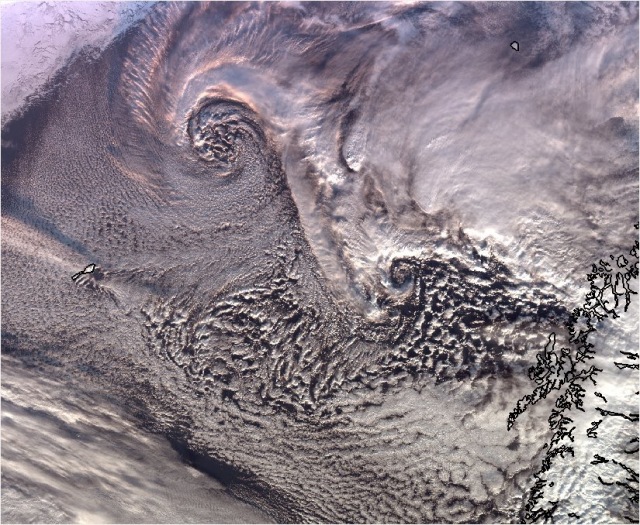
Thanks to the polar low group at the Norwegian met office in Tromsø for letting us know through BarentsWatch.
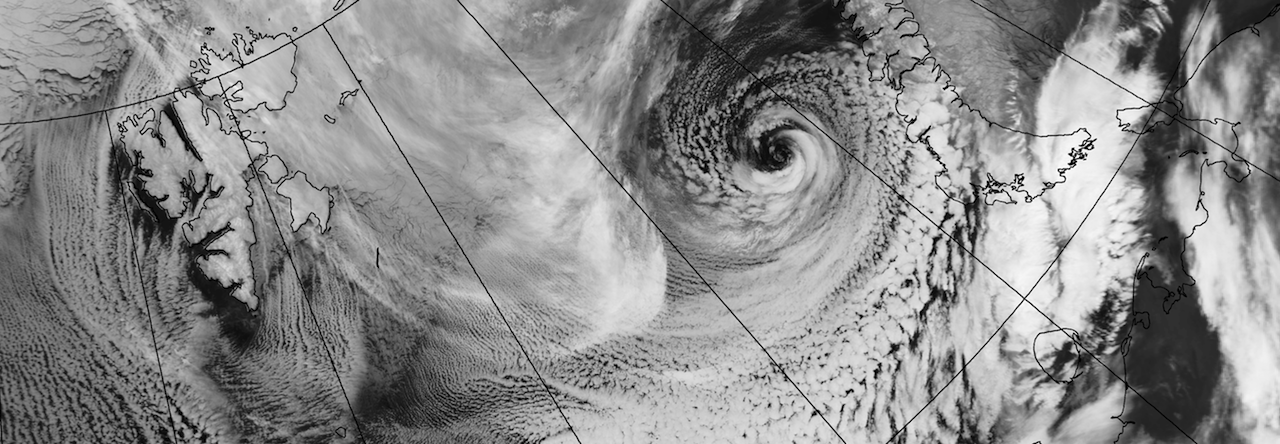
I went through a list of the most extreme cold air outbreaks in the last few decades today, and found this one:
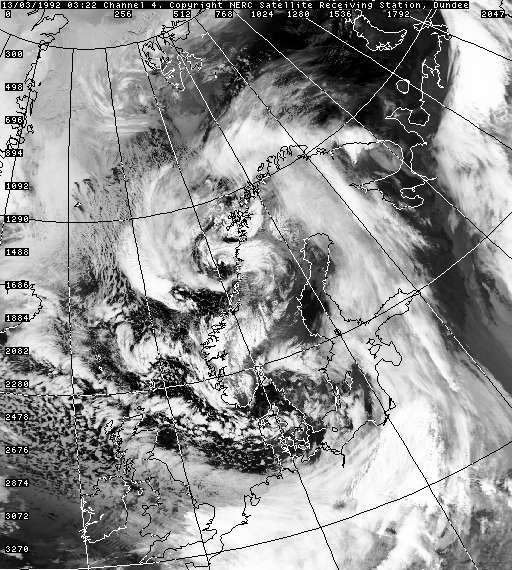
It might be just me, but I thought this one was particularly beautiful, with prettym uch the whole Norwegian Sea covered by polar lows. This was the third most extreme such outbreak in the period after 1979, at least according to the ERA-Interim reanalysis.
In a warming Arctic, things have changed and are going to change even more in the future. Check out this polar low north of Svalbard one year ago:
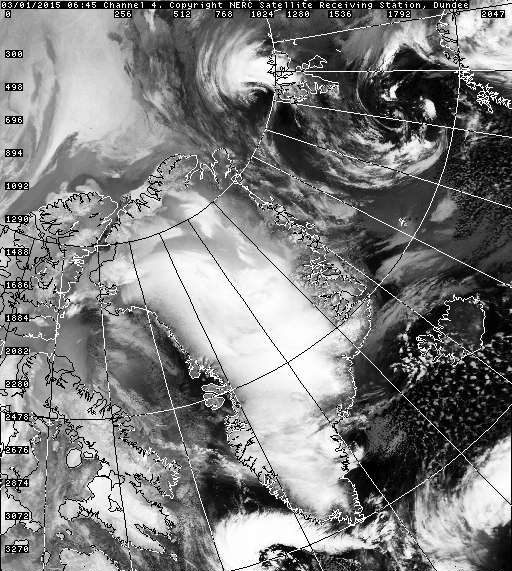
No sea ice north of Svalbard in January is unusual in itself, but a polar low to top it off? That’s pretty amazing.
There’s also a new paper out by Elizaveta Zabolotskikh et al.: New areas of polar lows over the Arctic as a result of the decrease in sea ice extent. The title speaks for itself, and their argument is that “new areas of open water appear where mesocyclones can arise”.
The thing is that polar lows can’t form over sea ice, so when the sea ice retreats, new ocean areas with relatively warm water are exposed to cold air outbreaks, just the environment that is most favourable for polar low formation.
One of the consequences is that the Kara Sea (east of Novaya Zemlya) suddenly also becomes prone to polar lows, and this is bad news because this is along the Northern Sea Route (which allows ships to travel from Asia to Europe way faster than through the Suez Canal).
This winter is not much better in terms of “missing” sea ice. Here’s an image from the National Snow and Ice Data Center in the US:
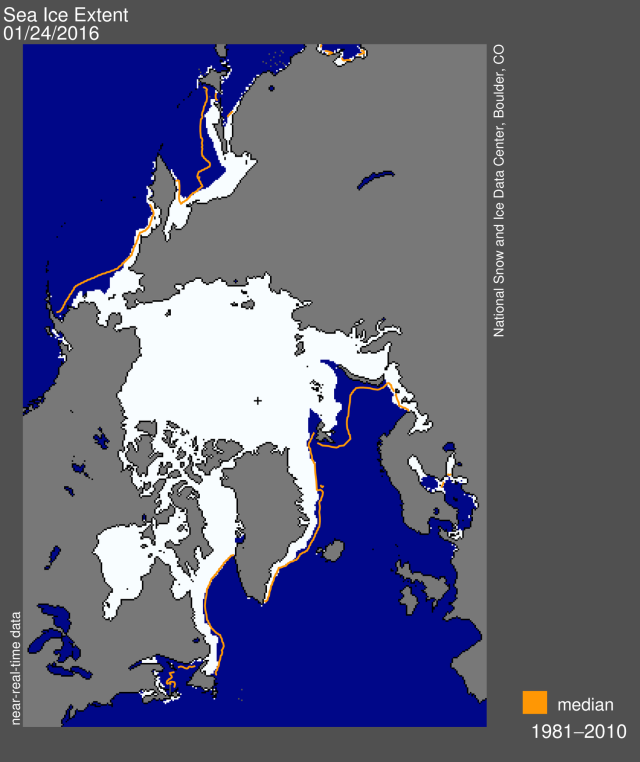
There is little doubt that polar lows can form further north than they usually do, and there is also little doubt that this is a portent of things to come.
At least three, maybe even four, polar lows were active over the Barents Sea last night. Here’s a nice satellite image taken early Monday morning:
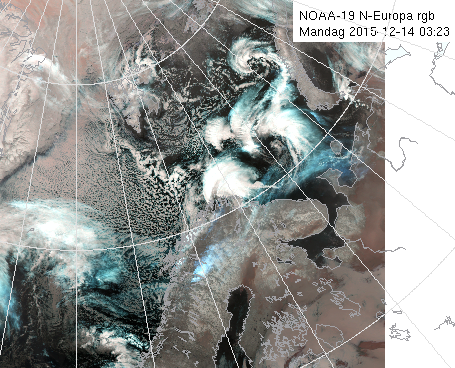
All of these are in the category of cyclones known as “comma clouds”, obviously because they look like inverted commas. As a side-note, maybe they should rather be called “apostrophe clouds”. Anyway, they are what we call baroclinic. That means that the low near the surface is linked to a trough higher up in the atmosphere, and these are not located on top of each other. This vertical structure allows the two lows to work together and to strengthen each other.
For more about this interesting mechanism, check out the Norwegian cyclone model, which was developed by the Bergen school of meteorology.
Most polar lows start out as baroclinic, but many of the develop a warm core and gradually enter a phase where they go from baroclinic to barotropic. Then the lows aloft and near the surface are locked in phase and no longer help each other grow. For the polar low to intensify in this stage, it needs to get its energy from the warm ocean surface.
This is how tropical cyclones (hurricanes) get their energy, too, and some polar lows are in certain ways similar to hurricanes. But so far all the research that has been done on “arctic hurricanes” has shown that the ocean surface is far too cold in the Arctic. In fact, we have a paper in review right now where we look at one such polar low.
Here’s another nice image of the current polar lows:
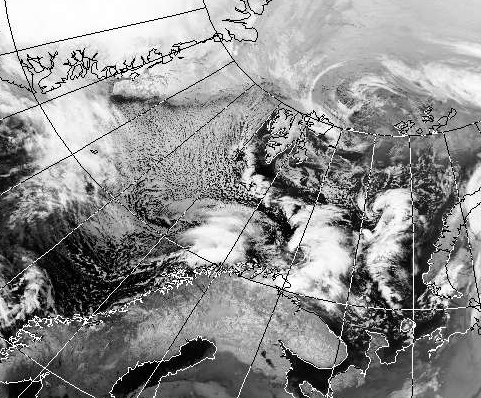
The cold air outbreak that I wrote about a few days ago will hit the UK tomorrow (Sunday), with subzero temperatures as far south as London. Here’s a picture of the cold air on its way southwards, taken from Bergen today:
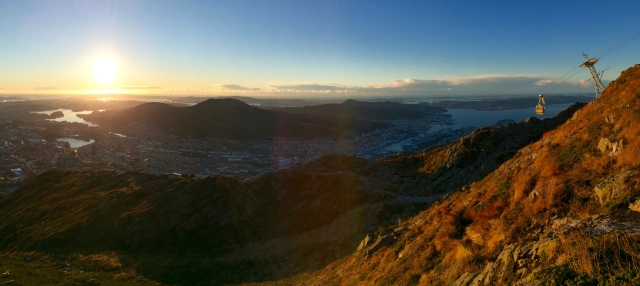
The tall clouds are “mild” Cumulonimbus clouds forming as the moist, warm air over the sea surface rises in the cold air from the Arctic. I remember seeing such clouds, albeit more vigorous ones, during the IPY-THORPEX polar low field campaign in Andøya in northern Norway in March 2008.
I just got an alert from the excellent BarentsWatch site about a polar low off the coast of northern Norway. Here’s the latest satellite image (downloaded from yr.no):

You can clearly see the dual system between Iceland and Norway, and what’s nice about this is that we also see the edge of the cold air outbreak stretching west from the polar lows. Here are some satellite-based wind speeds from about 1600 GMT yesterday, taken from this site:
This shows nicely how strong the winds are along the edge of the outbreak.
Update: I just found winds from this morning, too, and here wind speeds of more than 50 knots (Force 10 on the Beaufort wind force scale) were estimated by the satellite:
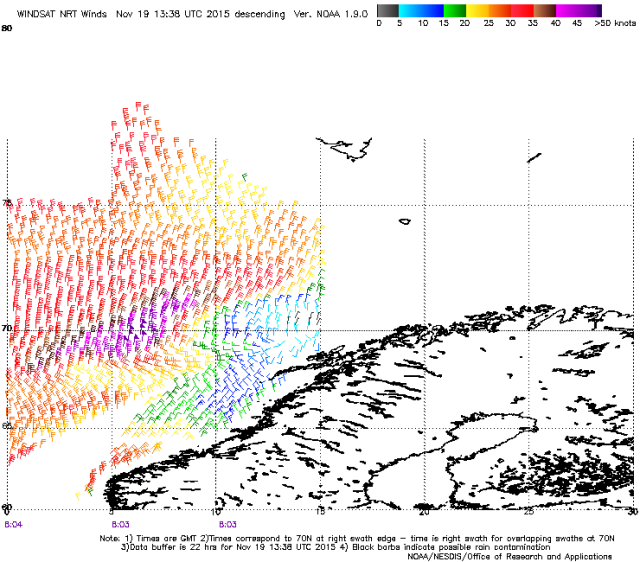
That’s pretty hefty. We can trace the development back to the disturbance seen in this picture from Wednesday, a few hours before the wind snapshot above:
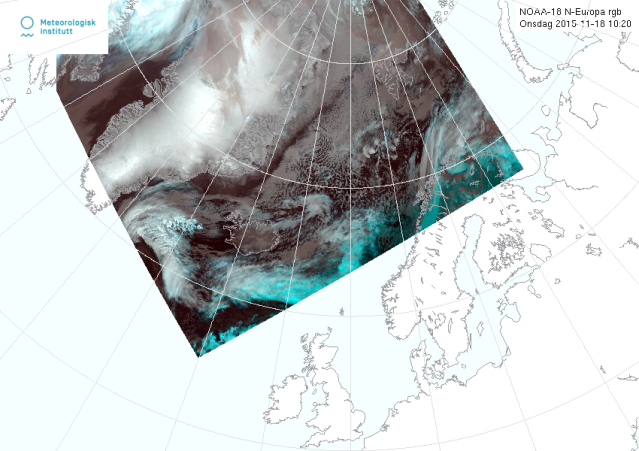
It’s moving slowly, but seems to have built some strength since yesterday.
Our good friend at the Norwegian Met Office in Tromsø, Gunnar Noer, just told me that they observed the first polar low (with an impact on Norway) this season a few days ago. Here’s a satellite image taken at 18:21 on 26 October 2015:
The polar low is clearly visible just north of northern Norway. At 20:00 UTC the polar low is more developed:
It’s also clear that the polar low formed in a cold air outbreak well north of the well polar front (the region that separates cold air in the north from warm air in the south), which is one of the main characteristics of polar lows.
I also found an image of satellite-derived surface wind speeds from the ASCAR radar (click image for higher resolution):
This shows that the polar low produced fairly strong winds. There’s plenty of other interesting features as well (as in pretty much every satellite image):
At the end of last year, a cold air outbreak over the Nordic Seas spawned a couple of nice polar lows. This picture was taken on Christmas Day:
The cold air outbreak reached down to Iceland, but there was a boundary-layer cold front, or what we would call an Arctic front, just north of 70 degrees north. These fronts can be nasty in themselves, with strong surface wind speeds and lots of snow, and they also breed polar lows. In the picture above there were two such lows. The only one that developed further, though, was the one on the right.
Here’s a picture taken about 36 hours later:
By this time the eastern part of the Arctic front has moved south, while the polar low stayed put. The white clouds indicate deep convection, meaning that it had developed tall clouds and probably lots of precipitation. The official meteorological station in Tromsø got 35 mm of snow during 25 and 26 December. Arctic fronts are much more shallow, as testified by the clouds along the one in the picture, but they can easily produce thunderstorms and heavy snow.
We received the following e-mail from Prof. Kent Moore at the University of Toronto:
NASA today published a striking image of cloud streets over the Lab Sea. […] The low that was causing the trouble in Iceland can be seen up along the SE coast of Greenland. The flow distortion traced out by the clouds is striking as is the nascent polar low. You can see a slight ‘kink’ in the sea-leve pressure field from the ECMWF analysis.
This is a thumbnail of the NASA image (click for more detail) and click here for the NASA page with even higher resolution:
This is the ECMWF analysis, where you can see the trough off the coast of Labrador:
This picture was taken just before noon on Friday 6 December 2013 (courtesy of the Dundee Satellite Receiving Station):
There is little reason to doubt that that’s a polar low up at 70 degrees north. It moves towards the south inside a cold air outbreak that covers much of the North Atlantic north of the British Isles.
There have been strong winds here in Bergen (at 60N on the west coast of Norway) ever since yesterday, when a strong low moved in from the west. The cold air outbreak is due to the northerly winds in the wake of that low. Check out the supply ships in the harbour of Bergen earlier today:
They have nowhere to go right now. The winds are fierce, there is a storm surge, and last night we had about 10 inches of snow. Pretty chaotic, in other words.
As for the polar low heading south, it’s a big one. This is an ECMWF wind speed forecast for later today (2100 GMT):
The wind speed is shown with colours in knots. On the Beaufort scale, the lightest one of the two red colours is strong gale and the darkest one is storm. The tiny black speck is violent storm, just one step below hurricane force. Now wonder those ships are staying put in Bergen.
For the weather nerds, note that the air pressure in the polar low is quite high compared to other storms. The strong winds are due to the gradients between the polar low and the ridge over Greenland. In addition, the low is moving southwards, so that adds to the strong southerly winds near the core of the low.
Also note the extreme wind speed gradients. It is all but calm to the north-east of the low. This is another reason that polar lows are dangerous, the insane local variations, from violent storm to nothing in just a few tens of kilometers.
As for the path of the polar low, it looks like it’s going to die before it hits land. By early Saturday morning it will be over.